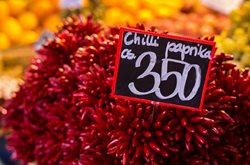
Particular pleasures await a foodie in Hungary’s bustling capital. Peeling back the layers of influence that make up this eclectic Central European cuisine, which combines Asian and European flavors and cooking methods, requires the gourmand to step into the historian’s shoes to appreciate the centuries and civilizations at work.
A great place to begin this culinary archeology is at Budapest’s elegant Central Market, built in 1896 to preside over one end of the capital’s elegant shopping thoroughfare, Vací Utca. Three tiers of market stalls boast the fertile abundance of the Danube basin, as well as hinting at Hungary’s nomadic and herdsman Magyar past. Butcher shops sell both fresh and cured pork, beef, and poultry, which are the key ingredients in some of Hungary’s signature dishes, such as the renowned Újházi (chicken soup) and gulyás or goulash, which is neither soup nor stew, but something gloriously in between, and harkens back to the herdsman who first cooked the dish in pots over open fires as they tended their sheep.
Hanging from almost every stall on the first floor are the ubiquitous peppers from which Hungary’s signature spice, paprika, is made. But paprika is actually an import, brought to the region during the 150-year Turkish invasion, just as garlic, cheese, and onions were brought to Hungary by a 15th Century Italian bride of King Matthais. Although paprika originally came to Europe and the Mediterranean from the Americas during the Voyages of Discovery, the Hungarians have claimed it for their own. Thanks to the sweet accents and vibrant red color of the strain of ancho chili peppers, which grow so well in the rich Danube soil, Hungarian paprika considered superior to other red peppers, and is an essential ingredient for other country’s national dishes, such as Spanish paella.
The buzz and vibe of the Central Market is also indicative of the exciting culinary renaissance happening throughout Central Europe today. Budapest is no exception, and while Hungarians show no sign of eschewing their traditional dishes, enterprising Hungarian and Western chefs are enjoying rave reviews and garnering prestigious culinary accolades for their efforts to lighten up the recipes in innovative new interpretations at some of Budapest’s finest restaurants such as Fausto’s and Onyx. The elegance and high quality of these restaurants have helped regain Budapest its well-earned 19th Century reputation as a culinary hub in Europe!
Alexander + Roberts include a trip to the Central Market and a private lesson in preparing Hungarian goulash on the popular privately guided
Budapest, Krakow + Prague itinerary.